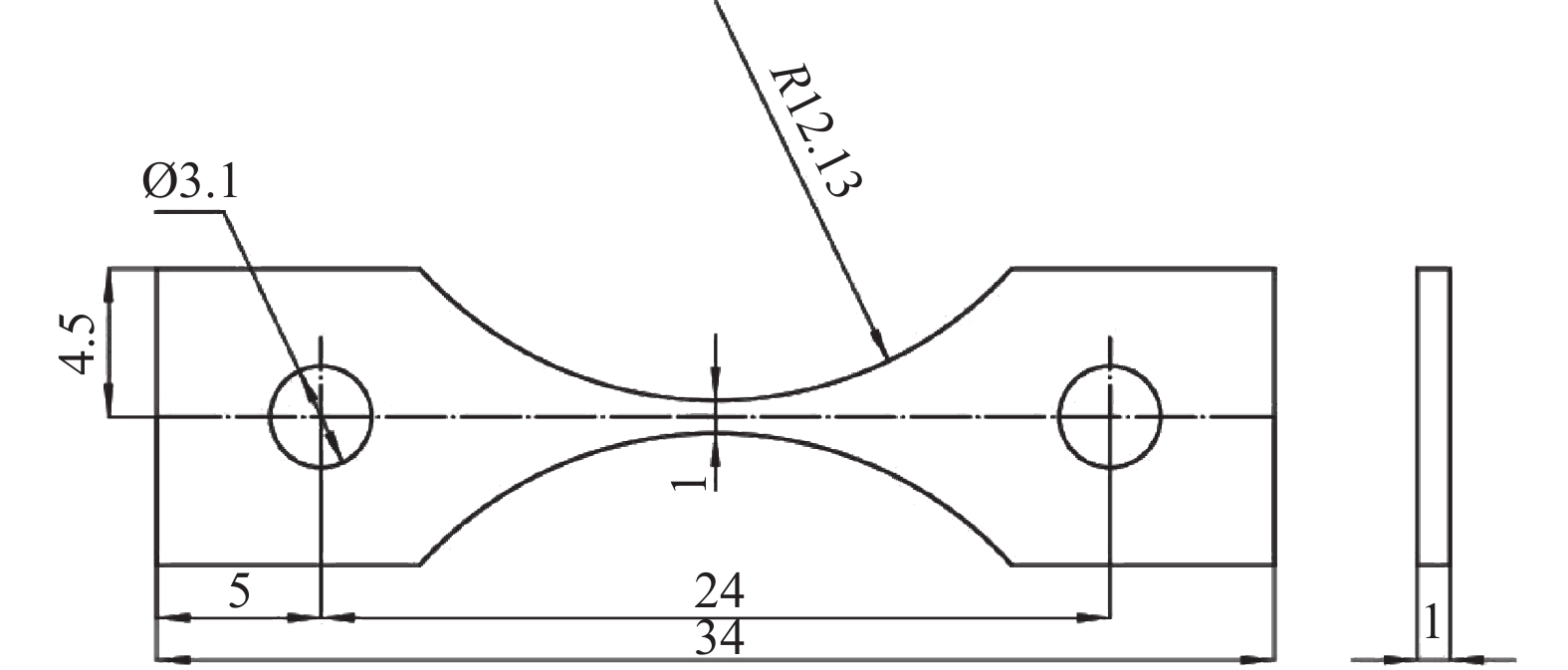-
摘要: 通过对M390粉末冶金刀具钢材料进行扫描电子显微组织观察、X射线衍射分析以及原位拉伸试验,研究了M390粉末冶金刀具钢微观组织结构和拉伸断裂行为,并分析了碳化物在粉末冶金刀具钢断裂过程中的作用。研究发现:M390粉末冶金刀具钢的显微组织是由基体和分布在基体上的碳化物两部分组成,其中基体组织为铁素体,碳化物则包括富铬等合金元素的M7C3和M23C6型碳化物,这些碳化物相严重影响M390粉末冶金刀具钢的断裂。随着外加载荷增加,分布在基体上的碳化物相提前开裂,形成裂纹源,裂纹呈现穿过或绕过碳化物的形式扩展,在进一步加载的情况下,裂纹处形成应力集中,导致基体发生脆性断裂。碳化物相成为M390粉末冶金刀具钢断裂过程的薄弱环节。试样断口呈现脆性断裂特征,并包含少量韧窝,且韧窝中存在第二相质点,即碳化物。Abstract: The microstructure and tensile fracture behavior of M390 powder metallurgy tool steels were investigated by scanning electron microscopy, X-ray diffraction analysis, and in-situ tensile test, and the effect of the carbides on the fracture process of the powder metallurgy tool steels was analyzed. The results show that, the microstructures of the M390 powder metallurgy tool steels are composed of the ferrite matrix and carbides as M7C3 and M23C6 with the chromium-rich alloy elements. These carbide phases seriously affect the fracture processes of M390 powder metallurgy tool steels. With the increase of the applied load, the cracks are firstly presented at the carbide phases distributed on the matrix, then propagate through or bypass the carbides. With the further increase of the applied load, the stress concentration at the tip of cracks causes the brittle fracture of the matrix. The carbide phases become the weakest in the fracture process of the M390 powder metallurgy tool steels. The fracture of the tool steel samples shows the brittle fracture characteristics and contains a small amount of dimples with the carbides inside.
-
表 1 M390钢化学成分(质量分数)
Table 1. Chemical composition of the M390 steels
% C Cr Mn+Mo+Si+V W S Fe 1.830 19.200 5.900 0.310 0.004 余量 表 2 M390钢断口成分分析(质量分数)
Table 2. Composition analysis of the M390 steels at fracture surface
% 区域 C N Si Mo V Cr Mn Fe 1 4.60 — 0.50 0.30 5.10 43.00 0 45.40 2 11.03 — 1.52 1.94 3.35 36.20 0 33.76 -
[1] Hell M P, Phelh H L. Modern development in powder metallurgy. Plenum Press, 1977, 4(20): 573 [2] Ruiz-Navas E M, Gordo E, Velasco F J. Development and characterization of high-speed steel matrix composites gradient materials. J Mater Process Technol, 2003, 143: 769 [3] Jia C C, Wu L Z. Powder metallurgy high speed steel. Met World, 2012(2): 5 doi: 10.3969/j.issn.1000-6826.2012.02.002贾成厂, 吴立志. 粉末冶金高速钢. 金属世界, 2012(2): 5 doi: 10.3969/j.issn.1000-6826.2012.02.002 [4] Deng Y K, Cheng J R, Wang S Z. High-Speed Tool Steel. Beijing: Metallurgical Industry Press, 2002邓玉坤, 陈景榕, 王世章. 高速工具钢. 北京: 冶金工业出版社, 2002 [5] Wang H P, Chen D. Research progress on fatigue crack initiation and propagation of powder high speed steel. Powder Metall Technol, 2016, 34(4): 300王辉平, 陈鼎. 粉末高速钢疲劳裂纹萌生与扩展的研究进展. 粉末冶金技术, 2016, 34(4): 300 [6] Geng W F. The current situation and prospects of tool steel. Mater Rev, 1992(1): 21耿文范. 工具钢的现状与展望. 材料导报, 1992(1): 21 [7] Varez A, Levenfeld B, Torralba J M, et al. Sintering in different atmospheres of T15 and M2 high speed steels produced by a modified metal injection mounding process. Mater Sci Eng A, 2004, 366(2): 318 doi: 10.1016/j.msea.2003.08.028 [8] Mesquita R A, Barbosa C A. Spray forming high speed steel—properties and processing. Mater Sci Eng A, 2004, A383(1): 87 [9] Romano P, Velasco F J, Torralba J M, et al. Processing of M2 powder metallurgy high-speed steel by means of starch consolidation. Mater Sci Eng A, 2006, A419(1-2): 1 [10] Utari B, Kosec L, Jenko M, et al. Vacuum sintering of water-atomized HSS powders with MoS2 additions. Vacuum, 2001, 61(2-4): 471 doi: 10.1016/S0042-207X(01)00161-0 [11] Asgharzadeh H, Simchi A. Effect of sintering atmosphere and carbon content on the densification and microstructure of laser-sintered M2 high-speed steel powder. Mater Sci Eng A, 2005, 403(1-2): 290 doi: 10.1016/j.msea.2005.05.017 [12] Gimenez S, Iturriza I. Microstructural characterization of powder metallurgy M35MHV HSS as a function of the processing route. J Mater Process Technol, 2003, 143-144: 555 doi: 10.1016/S0924-0136(03)00359-5 [13] Trabadelo V, Giménez S, Iturriza I. Microstructural characterisation of vacuum sintered T42 powder metallurgy high-speed steel after heat treatments. Mater Sci Eng A, 2009, 499(1-2): 360 doi: 10.1016/j.msea.2008.08.043 [14] Godec M, Bati B E, Mandrino D, et al. Characterization of the carbides and the martensite phase in powder-metallurgy high-speed steel. Mater Charact, 2010, 61(4): 452 doi: 10.1016/j.matchar.2010.02.003 [15] Harlin P, Olsson M. Abrasive wear resistance of starch consolidated and sintered high speed steel. Wear, 2009, 267(9-10): 1482 doi: 10.1016/j.wear.2009.03.022 [16] Rech J, Yen Y C, Schaff M J, et al. Influence of cutting edge radius on the wear resistance of PM-HSS milling inserts. Wear, 2005, 259(7-12): 1168 doi: 10.1016/j.wear.2005.02.072 [17] Torres Y, Mateo A, Anglada M, et al. Fatigue behavior of powder metallurgy high-speed steels: fatigue limit prediction using a crack growth threshold-based approach. Mater Sci Eng A, 2004, 387: 501 [18] Chatterjee D, Oraon B, Sutradhar G, et al. Prediction of hardness for sintered HSS components using response surface method. J Mater Process Technol, 2007, 190(1-3): 123 doi: 10.1016/j.jmatprotec.2007.03.069 [19] Chen S Q, Huang B Y. Research status and progress of metal powder gas atomization preparation technology. Powder Metall Technol, 2004(5): 297陈仕奇, 黄伯云. 金属粉末气体雾化制备技术的研究现状与进展. 粉末冶金技术, 2004(5): 297 [20] Wen X H, Ding X Q, Han X Y, et al. Optimization of M42 high speed steel powder ball milling process and SPS sintering. Powder Metall Technol, 2010, 28(4): 288文小浩, 丁小芹, 韩小云, 等. M42高速钢粉末球磨工艺优化及其SPS烧结. 粉末冶金技术, 2010, 28(4): 288 [21] Ouyang Q, Yu Y L, Huang Y P, et al. Research on properties of M3:2 powder high speed steel under different sintering atmospheres. Powder Metall Technol, 2016(5): 351欧阳齐, 于永亮, 黄雍平, 等. 不同烧结气氛下M3:2粉末高速钢的性能研究. 粉末冶金技术, 2016(5): 351 [22] Jian F, Shen J, Cao F Y, et al. Evaluation of the cooling rate of spray-formed nickel-based superalloys. Powder Metall Technol, 2002(3): 33剑飞, 沈军, 曹福洋, 等. 喷射成形镍基高温合金冷却速度的评价. 粉末冶金技术, 2002(3): 33 [23] Pi Z Q, Lu X, Jia C C, et al. Research progress of spray forming high speed steel. Powder Metall Technol, 2013(5): 61 doi: 10.3969/j.issn.1001-3784.2013.05.012皮自强, 路新, 贾成厂, 等. 喷射成形高速钢的研究进展. 粉末冶金技术, 2013(5): 61 doi: 10.3969/j.issn.1001-3784.2013.05.012 [24] Wen X H, Chen S, Ding X Q. Microstructure and properties of SPS sintered M42 powder metallurgy high speed steel. Powder Metall Technol, 2010, 28(1): 39文小浩, 陈胜, 丁小芹, 等. SPS烧结M42粉末冶金高速钢的显微组织与性能. 粉末冶金技术, 2010, 28(1): 39 [25] Chatterjee D, Sutradhar G, Oraon B. Fuzzy rule-based prediction of hardness for sintered HSS components. J Mater Process Technol, 2008, 200(1-3): 212 doi: 10.1016/j.jmatprotec.2007.09.057 [26] Liu Z Y, Loh N H, Khor K A, et al. Microstructure evolution during sintering of injection molded M2 high speed steel. Mater Sci Eng A, 2000, 293(1-2): 46 doi: 10.1016/S0921-5093(00)01244-2 [27] Badger J. Grindability of conventionally produced and powder-metallurgy high-speed steel. Cirp Ann Manuf Technol, 2007, 56(1): 353 doi: 10.1016/j.cirp.2007.05.081 [28] Wu Y C. The progress of powder metallurgy tool steel abroad in recent years. Powder Metall Ind, 2004, 14(4): 24吴元昌. 近年国外粉末冶金工具钢的进展. 粉末冶金工业, 2004, 14(4): 24 [29] Xu G L, Huang P, Sun X, et al. Research status and development trend of powder metallurgy tool steel preparation and heat treatment process. Prog Chin Mater, 2020(1): 70徐桂丽, 黄鹏, 孙溪, 等. 粉末冶金刀具钢制备和热处理工艺的研究现状及发展趋势. 中国材料进展, 2020(1): 70 [30] Cheng N L. Preparation, Microstructure and Properties of T15 Powder Metallurgy Tool Steel [Dissertation]. Harbin: Harbin Institute of Technology, 2012陈年莲. T15粉末粉末冶金刀具钢制备及组织和性能研究[学位论文]. 哈尔滨: 哈尔滨工业大学, 2012 [31] Yu W T, Li J, Shi C B, et al. Effect of titanium on the microstructure and mechanical properties of high-carbon martensitic stainless steel 8Cr13MoV. Heat Treat Met, 2016, 6(8): 193于文涛, 李晶, 史成斌, 等. 高碳马氏体不锈钢8Cr13MoV球化退火过程中碳化物的演变. 金属热处理, 2016, 6(8): 193 [32] Lima E P R, das Neves M D M, Nogueira R A, et al. Effect of different tempering stages and temperatures on microstructure, tenacity and hardness of vacuum sintered HSS AISI T15 // International Latin American Conference on Powder Technology. Buzios, 2007: 68 [33] Kim H Y, Kang J Y, Son D M, et al. Evolution of carbides in cold-work tool steels. Mater Charact, 2015, 107: 376 doi: 10.1016/j.matchar.2015.08.001 [34] Rao Y, Zheng L, Liu X G, et al. Effect of carbon content on microstructure and tensile properties of CoCrMo alloy. Mater Eng, 2009, 5(3): 14饶洋, 郑亮, 刘晓功, 等. 碳含量对CoCrMo合金显微组织和拉伸性能的影响. 材料工程, 2009, 5(3): 14 [35] Peng H, Hu L, Ngai T, et al. Effects of austenitizing temperature on microstructure and mechanical property of a 4-GPa-grade PM high-speed steel. Mater Sci Eng A, 2018, 719: 21 doi: 10.1016/j.msea.2018.02.010 [36] Pan F S, Wang W Q, Tang A T, et al. Phase transformation refinement of coarse primary carbides in M2 high speed steel. Prog Nat Sci Mater Int, 2011(2): 180 [37] Yang B. Preparation and Microstructure and Properties of Powder Tool Steel [Dissertation]. Lanzhou: Lanzhou University of Technology, 2020杨博. 粉末刀具钢制备及组织和性能研究[学位论文]. 兰州: 兰州理工大学, 2020 -




 下载:
下载:








